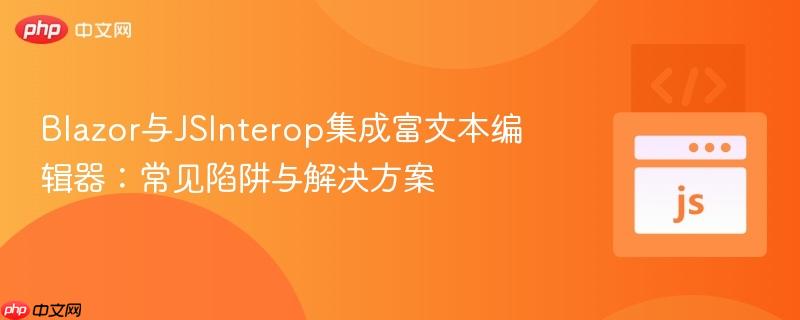
本文深入探讨了在blazor应用中使用jsinterop构建富文本编辑器时常见的两个问题:事件监听器重复注册导致的双击和多重提示,以及blazor组件重渲染导致的内容丢失。通过优化jsinterop调用方式和利用blazor的`shouldrender()`生命周期方法,文章提供了清晰的解决方案,旨在帮助开发者实现blazor与javascript的无缝高效集成,避免潜在的运行时问题。
在Blazor应用中集成富文本编辑器时,开发者常会遇到需要与底层JavaScript API(如document.execCommand)进行交互的场景。JSInterop是实现这一目标的关键机制。然而,不当的JSInterop使用方式可能导致一些难以察觉的问题,尤其是在处理事件监听和DOM元素状态时。本教程将深入分析两个常见问题:按钮点击需要两次才能生效,以及图像插入功能触发多次提示且无法显示图片。
假设我们有一个Blazor组件,其中包含一个可编辑的div和一个工具栏,工具栏上的按钮通过@onclick事件触发C#方法,进而调用JSInterop来执行相应的富文本命令。
初始HTML结构:
<div class="main-content">
<div class="text-editor-header">
<button @onclick="showChange" type="button" class="btn" data-element="bold">
<i class="fa fa-bold"></i>
</button>
<button @onclick="showChange" type="button" class="btn" data-element="justifyFull">
<span class="fa fa-align-justify"></span>
</button>
<button @onclick="showChange" type="button" class="btn" data-element="insertImage">
<span class="fa fa-image"></span>
</button>
</div>
<div class="content" id="content" contenteditable="true"></div>
</div>C#代码:
@inject IJSRuntime JsRuntime
// ... 其他代码 ...
async Task showChange()
{
await JsRuntime.InvokeVoidAsync(identifier: "buttonPressed");
}JavaScript代码 (JSInterop.js):
function buttonPressed() {
const elements = document.querySelectorAll('.btn');
elements.forEach(element => {
element.addEventListener('click', () => { // 问题所在:重复注册事件监听器
let command = element.dataset['element'];
if (command == 'createLink' || command == 'insertImage') {
let url = prompt('Enter the link here:', 'http://');
document.execCommand(command, false, url);
} else {
document.execCommand(command, false, null);
}
});
});
}在这种实现中,我们观察到两个主要问题:
要解决上述问题,我们需要从两个方面入手:
最佳实践是让Blazor组件直接知道要执行什么命令,并将该命令作为参数传递给JavaScript函数。这样,JavaScript函数只需要执行传入的命令,而不需要关心事件注册。
更新C#代码:
修改showChange方法,使其接受一个command字符串参数,并将其传递给JavaScript。
async Task showChange(string command)
{
await JsRuntime.InvokeVoidAsync(identifier: "buttonPressed", command);
}更新JavaScript代码 (JSInterop.js):
修改buttonPressed函数,使其直接接收command参数,并根据该参数执行相应的document.execCommand。
function buttonPressed(command) {
if (command == 'createLink' || command == 'insertImage') {
let url = prompt('Enter the link here:', 'http://');
document.execCommand(command, false, url);
} else {
document.execCommand(command, false, null);
}
}更新HTML中的按钮绑定:
现在,每个按钮的@onclick事件可以直接调用showChange并传递其对应的命令。
<button @onclick='@(() => showChange("bold"))' type="button" class="btn">
<i class="fa fa-bold"></i>
</button>
<button @onclick='@(() => showChange("justifyFull"))' type="button" class="btn">
<span class="fa fa-align-justify"></span>
</button>
<button @onclick='@(() => showChange("insertImage"))' type="button" class="btn">
<span class="fa fa-image"></span>
</button>通过这些修改,现在每次点击按钮时,Blazor会直接调用JavaScript中的buttonPressed函数,并传入正确的命令。JavaScript函数会立即执行该命令,而不会重复注册事件监听器,从而解决了双击和多重提示的问题。
即使解决了事件监听器的问题,Blazor的默认渲染行为仍可能导致contenteditable div中的内容在每次组件状态更新时被清除。为了防止这种情况,我们可以将contenteditable div封装在一个独立的Blazor组件中,并重写其ShouldRender()方法。
创建独立的EditableContent组件 (EditableContent.razor):
<!-- EditableContent.razor -->
<div class="content" id="content" contenteditable="true"></div>
@code {
protected override bool ShouldRender()
{
// 阻止Blazor重新渲染此组件,因为其内容将由JavaScript直接管理
return false;
}
}在主组件中使用EditableContent组件:
<div class="main-content">
<!--Text Editor Header-->
<div class="text-editor-header">
<!-- ... 你的按钮代码 ... -->
</div>
<EditableContent /> <!-- 使用新的独立组件 -->
</div>通过将contenteditable div放入一个独立的组件,并设置ShouldRender() => false,我们告诉Blazor:一旦这个组件被添加到DOM中,就不要再对其进行任何渲染更新。这样,JavaScript对div内容的修改将不会被Blazor的后续渲染操作所覆盖。
在Blazor应用中利用JSInterop与JavaScript进行交互时,尤其是在构建富文本编辑器这类需要频繁操作DOM的场景,遵循以下最佳实践至关重要:
通过遵循这些原则,您可以有效地利用Blazor的JSInterop功能,构建出稳定、高效且用户体验良好的富文本编辑器或其他需要深度JavaScript集成的功能。
以上就是Blazor与JSInterop集成富文本编辑器:常见陷阱与解决方案的详细内容,更多请关注php中文网其它相关文章!

每个人都需要一台速度更快、更稳定的 PC。随着时间的推移,垃圾文件、旧注册表数据和不必要的后台进程会占用资源并降低性能。幸运的是,许多工具可以让 Windows 保持平稳运行。

Copyright 2014-2025 https://www.php.cn/ All Rights Reserved | php.cn | 湘ICP备2023035733号